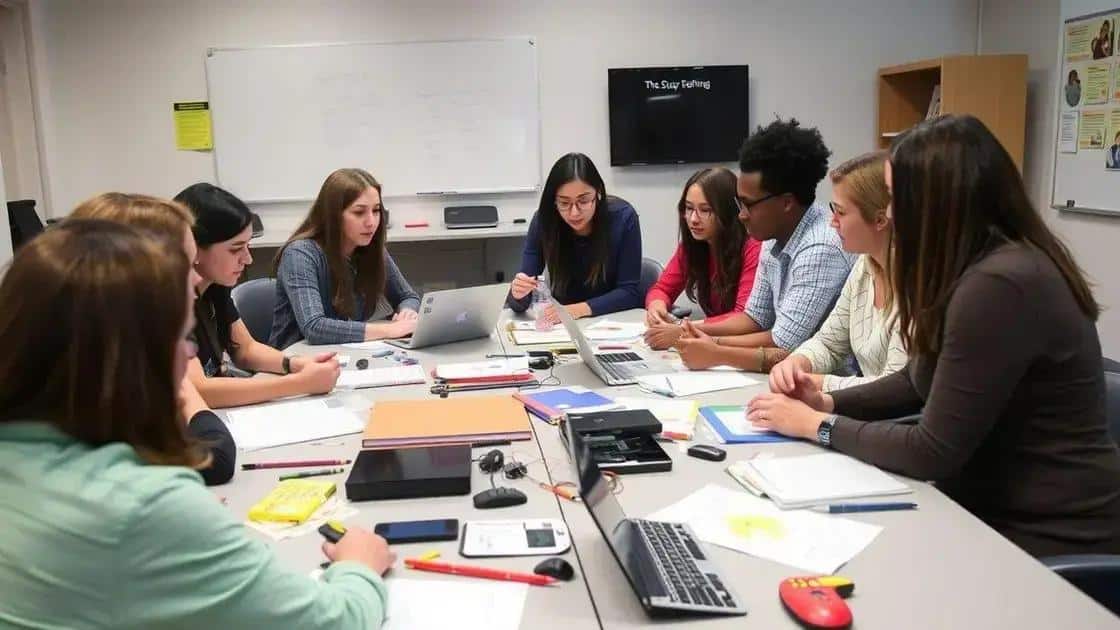Have teacher training initiatives changed education forever?

Teacher training initiatives are structured programs aimed at enhancing educators’ skills, which lead to improved teaching methods and subsequently better student learning outcomes.
Have teacher training initiatives become a cornerstone of modern education? They’ve gained attention for their potential to elevate teaching practices and improve student performance. In this article, we’ll delve into how these initiatives reshape the teaching landscape.
Understanding teacher training initiatives
Understanding teacher training initiatives is essential for enhancing the quality of education. These programs are designed to equip educators with the necessary skills and knowledge. They provide new strategies and techniques that improve classroom engagement and learning outcomes.
What Are Teacher Training Initiatives?
Teacher training initiatives refer to organized programs aimed at fostering professional development among educators. These initiatives can vary in format, including workshops, online courses, and in-service training. They focus on different aspects of teaching practice, from classroom management to technology integration.
The Importance of These Initiatives
These training programs are vital as they:
- Enhance teaching effectiveness.
- Support continuous professional growth.
- Encourage collaborative learning among teachers.
Through these initiatives, teachers can learn about the latest educational research and apply best practices in their own classrooms. Engaging with peers during training can also foster a sense of community, making educators feel more supported in their roles.
A significant aspect of teacher training initiatives is their adaptability. Different schools or districts might tailor their programs based on specific needs. For example, a school struggling with technology might focus on digital tools while another might highlight inclusive education strategies.
Successful Examples
Many districts have seen positive results from implementing effective training programs:
- Increased student engagement.
- Higher test scores.
- Improved teacher retention rates.
Such outcomes demonstrate how vital these initiatives are in fostering a productive learning environment.
Additionally, ongoing support plays a crucial role in the success of teacher training initiatives. Providing mentors or follow-up sessions can help reinforce what teachers learn, ensuring they can apply these strategies effectively in the classroom.
Impact of teacher training on student outcomes
The impact of teacher training on student outcomes is significant and profound. When teachers engage in ongoing professional development, they are better equipped to meet the diverse needs of their students. This creates an environment where all learners can thrive.
How Teacher Training Influences Learning
Training provides educators with new strategies and methods. As teachers learn about differentiated instruction, they can better cater to varied learning styles. When teachers understand how to implement these strategies, students often show improved engagement and performance.
Positive Outcomes from Training Programs
Many studies indicate a direct link between high-quality training and improved student achievement:
- Students in classrooms with trained teachers tend to score higher on standardized tests.
- Teacher training helps reduce dropout rates.
- Classes become more inclusive, accommodating students with special educational needs.
This shows that teacher effectiveness is crucial for student success. Engaging with peers in training sessions can inspire teachers to try new approaches. As they gain confidence, they’re likely to take risks in their teaching, which can lead to greater student motivation.
A strong foundation in teacher training has lasting effects. For example, students taught by teachers who consistently participate in professional development often demonstrate better critical thinking skills. These experiences teach students how to analyze information and approach problems creatively.
Real-Life Examples of Success
Several districts have implemented successful teacher training initiatives resulting in measurable improvements:
- Increased literacy rates.
- Higher overall student satisfaction.
- Greater collaborative projects between students.
These examples highlight the importance of investing in teacher training. As schools prioritize professional development, they can create a cycle of continuous improvement that benefits both teachers and students.
Best practices in teacher professional development

Implementing the best practices in teacher professional development is crucial for enhancing educators’ skills and student learning. These practices focus on continuous improvement and adapting to new teaching methods.
Effective Professional Development Strategies
Quality training involves engaging teachers in various methods. Workshops and seminars can be beneficial, but real growth often happens through collaboration and active participation. Teachers thrive when they can share their experiences and learn from one another.
Key Elements of Successful Training
Effective professional development should include:
- Relevance to teachers’ needs and classroom challenges.
- Opportunities for hands-on practice.
- Support and resources for ongoing learning.
When training sessions align with teachers’ specific situations, they become more impactful. For instance, if a training focuses on integrating technology in the classroom, teachers may find it easier to translate that knowledge into their lessons.
Moreover, ongoing support after training is vital. Establishing communities of practice can help teachers implement what they learn. These communities allow educators to seek advice, share successes, and continue discussing new methods.
The Role of Coaching in Professional Development
Coaching offers a personalized approach to professional growth. Having a mentor who observes and provides feedback can lead to significant improvements. This supportive relationship enables teachers to reflect on their practices and make necessary adjustments.
Additionally, setting specific goals during professional development can guide teachers in their journey. Clear goals allow educators to focus on what matters most, leading to tangible results in their classrooms. For example, a teacher might aim to improve student participation by using new collaborative techniques learned during training.
Incorporating feedback from students can also enhance professional development efforts. When teachers understand how their students respond to different teaching strategies, they can refine their methods. This student-centered approach creates a loop of continuous improvement.
Challenges faced in implementing training
Implementing training initiatives in education can bring several challenges. Understanding these obstacles helps schools and organizations prepare better and create effective solutions.
Common Obstacles in Training Implementation
One major challenge is securing funding for professional development programs. Limited budgets can restrict the type and frequency of training available. Additionally, schools may struggle to find time in the busy schedule for teachers to attend sessions.
Resistance to Change
Another issue is the natural resistance to change that some educators may feel. Many teachers are comfortable with established methods. Introducing new techniques can cause anxiety or reluctance to adapt, hindering the training’s effectiveness.
Moreover, different teachers have varying comfort levels with technology. For instance, some educators may find it challenging to integrate tech tools into their classrooms, leading to frustration. For successful training, it’s essential to address these differences and provide appropriate support.
Measurement of Effectiveness
Measuring the success of training programs also poses difficulties. Schools often lack clear metrics to assess how well the training translates into improved teaching practices or student outcomes. Without proper evaluation, it’s challenging to justify the investment in training.
Furthermore, ongoing support is vital, yet often overlooked. A one-time training session is usually not enough for lasting change. Continuous professional development is essential to help teachers implement what they’ve learned effectively.
Logistical Challenges
Logistical issues can further complicate training. Coordinating schedules to ensure all teachers can attend is a significant hurdle. Additionally, selecting the right trainers who can engage staff and deliver relatable content is critical to the training’s success.
To overcome these challenges, schools can foster a culture of collaboration and support for professional development. This might involve offering incentives for teachers who participate or form teams that encourage peer learning. Empowering educators to take ownership of their learning helps create a positive environment for professional growth.
Future trends in teacher training initiatives
Looking ahead, several exciting trends in teacher training initiatives are emerging. These trends aim to foster more effective teaching practices and better student outcomes. As education continues to evolve, it’s essential for training programs to keep pace.
Integration of Technology
One of the most significant changes in teacher training is the increasing integration of technology. Online platforms and digital tools are becoming commonplace in training sessions. For instance, virtual reality can provide immersive learning experiences that help teachers practice new skills in a risk-free environment.
Personalized Learning
Another trend is the move towards personalized training experiences. Instead of one-size-fits-all workshops, educators are seeking tailored professional development that meets their specific needs. This can include options such as:
- Individual coaching sessions.
- Customizable online courses.
- Peer mentoring opportunities.
By offering flexible learning paths, schools can ensure that every teacher has access to relevant knowledge and skills.
Focus on Social-Emotional Learning
Social-emotional learning (SEL) is gaining importance in teacher training as well. Educators are being trained to recognize and support students’ emotional needs. This is crucial for fostering a healthy classroom environment. Training programs are beginning to include methods for teaching empathy, resilience, and interpersonal skills.
In addition, the concept of lifelong learning is being embraced more fully. Teachers are encouraged to view their professional growth as an ongoing journey. Continuous education supports their development, allowing them to stay current with the latest research and best practices.
Collaboration and Networking
Networking and collaboration among educators are also emerging as key components of effective training. Schools are creating communities where teachers can share experiences and resources. Participating in collaborative projects can lead to innovative teaching strategies and shared goals.
Moreover, partnerships with universities and educational organizations are becoming more common. These alliances often provide access to research-backed practices and expert knowledge, enhancing the quality of teacher training.
As we consider the future of teacher training initiatives, it’s clear that innovation and adaptability will play significant roles. By embracing these trends, educational leaders can create a more dynamic and supportive environment for teachers, ultimately benefiting students.
In summary, effective teacher training initiatives are vital for enhancing educational quality and student success. As we look to the future, embracing technology and personalized learning will empower educators. Addressing challenges such as resistance to change and ensuring continuous support can lead to thriving teaching environments. By fostering collaboration and networking, schools can set the stage for innovative teaching practices. Ultimately, investing in teacher development creates a positive impact on both teachers and students.
FAQ – Frequently Asked Questions about Teacher Training Initiatives
What are teacher training initiatives?
Teacher training initiatives are organized programs designed to help educators improve their skills and adapt to new teaching methods.
How do these initiatives impact student learning?
Effective teacher training leads to enhanced teaching practices, which often result in better student engagement and improved academic outcomes.
What challenges do schools face in implementing these training programs?
Schools may struggle with funding, scheduling conflicts, and resistance from teachers who are hesitant to change their established methods.
What are some future trends in teacher training?
Future trends include increased technology integration, personalized learning experiences, and a focus on social-emotional learning for both teachers and students.






